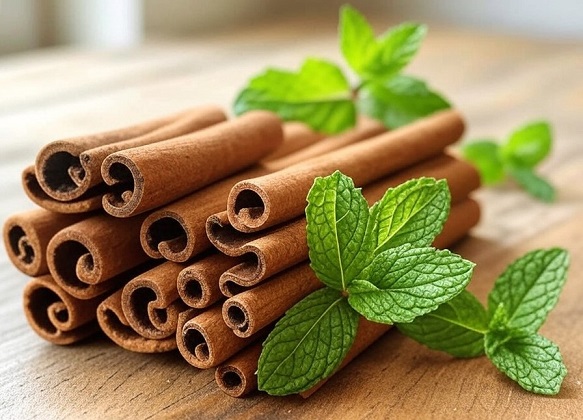Japanese Study Finds That the Flavors and Fragrance Extracts of Cinnamon and Mint Can Protect Against COVID-19
Nikhil Prasad Fact checked by:Thailand medical News Team Dec 25, 2024 3 months, 4 weeks, 1 day, 13 hours, 24 minutes ago
Medical News: The global spread of COVID-19, caused by the SARS-CoV-2 virus, has continued to challenge public health systems worldwide. Despite the advent of vaccines and a variety of preventive measures, innovative and accessible solutions are still in demand to curb infections and their lingering aftereffects. A recent study conducted by researchers from the Department of Microbiology and Immunology at Nihon University in Japan brings a novel perspective. Their findings suggest that everyday flavor and fragrance components, particularly cinnamon and mint, could play a vital role in preventing SARS-CoV-2 infections.
 Japanese Study Finds That the Flavors and Fragrance Extracts of Cinnamon and Mint Can
Japanese Study Finds That the Flavors and Fragrance Extracts of Cinnamon and Mint Can
Protect Against COVID-19. Image-AI-Generated
Exploring the Preventive Potential of Fragrances
The study delved into the potential of flavor and fragrance compounds to inhibit the interaction between the SARS-CoV-2 spike protein and the ACE2 receptor, a critical gateway for the virus to infect human cells. The researchers hypothesized that certain fragrances might provide a protective barrier, particularly in the oral cavity where initial viral interactions occur. This
Medical News report highlights their groundbreaking findings and implications for everyday preventive practices.
The research team tested a variety of fragrance compounds, including common substances like cinnamaldehyde and mint extracts. Utilizing VeroE6/TMPRSS2 cells - a standard model for studying SARS-CoV-2 infection - they evaluated the ability of these compounds to block viral entry. Their results revealed that cinnamon and mint flavors, widely available in foods and products, exhibited remarkable inhibitory effects on the virus.
The Study in Detail
To conduct their investigation, the researchers prepared solutions of fragrance compounds diluted in a phosphate-buffered saline. These solutions were then exposed to VeroE6/TMPRSS2 cells in the presence of SARS-CoV-2. The researchers monitored the interaction using an inhibition assay, a technique designed to measure the blocking of virus-receptor binding.
The study tested eight fragrance compounds, including cinnamaldehyde, methyl anthranilate, and dihydroactinidiolide, as well as blended fragrances like cinnamon flavor and cinnamon mint. The findings were compelling. Cinnamon flavor and mint demonstrated strong inhibitory effects on the virus at concentrations as low as 0.03125%. In contrast, some other compounds, like cinnamyl alcohol, showed limited effectiveness due to solubility challenges.
Additionally, the study verified that these fragrances did not harm the cells themselves. The researchers conducted cell viability tests using the MTT assay, which confirmed that the fragrances specifically targeted the virus without causing cytotoxicity.
Why Cinnamon and Mint Work
The study suggests that the inhibitory effects of cinnamon and mint stem from their physical interactions with the SARS-CoV-2 spike protein. By disrupting the protein-protein interaction necessary for viral en
try, these fragrances effectively reduced the virus’s ability to infect host cells. This unique mechanism highlights the potential of these compounds as affordable and practical tools for reducing viral transmission.
Cinnamon and mint are particularly appealing because of their widespread use in food products. Unlike synthetic drugs, these natural compounds are generally considered safe for consumption. Moreover, their potential to act as preventive agents aligns with existing hygiene practices, such as the use of mouthwash or chewing gum.
Broader Implications and Applications
The study’s findings open the door to a range of practical applications. For instance, incorporating cinnamon and mint into everyday products like toothpaste, chewing gum, and mouthwash could enhance their protective effects against SARS-CoV-2. Such products would not only provide oral hygiene but also create a hostile environment for the virus, potentially reducing its spread.
Another promising avenue is the development of food products enriched with these fragrances. The researchers highlighted the potential for “innovative foods” that could offer infection-inhibiting properties while being consumed as part of a regular diet. Such foods could serve as an accessible and non-invasive measure to enhance public health, particularly in areas with limited access to advanced medical care.
Challenges and Future Directions
While the findings are promising, the researchers acknowledge that further studies are needed to optimize the use of these fragrances. For example, improving the solubility and stability of compounds like cinnamyl alcohol could enhance their effectiveness. Additionally, the development of delivery systems that ensure sustained release of these fragrances in the oral cavity would be crucial for maximizing their protective benefits.
The study also underscores the need for comprehensive clinical trials to validate the efficacy of cinnamon and mint in real-world settings. Such trials would provide valuable data on the long-term safety and effectiveness of these compounds, paving the way for their integration into public health strategies.
Conclusion
The study’s findings hold significant promise for the fight against COVID-19. By leveraging the natural properties of cinnamon and mint, researchers have identified a practical and accessible solution to reduce the risk of SARS-CoV-2 infections. This approach not only complements existing preventive measures but also offers a cost-effective alternative for communities worldwide.
Incorporating these findings into everyday products could revolutionize the way we approach infection prevention. From toothpaste and chewing gum to innovative food products, the potential applications are vast. As researchers continue to refine their methods and explore new possibilities, the prospect of using natural fragrances to combat COVID-19 becomes increasingly viable.
The study findings were published in the peer-reviewed journal: Current Research in Microbial Sciences.
https://www.sciencedirect.com/science/article/pii/S2666517424001184
For the latest COVID-19 News, keep on logging to Thailand
Medical News.
Read Also:
https://www.thailandmedical.news/news/eucalyptus-extract-shows-promise-against-coronaviruses-and-influenza-viruses
https://www.thailandmedical.news/news/herbs-and-phytochemicals-in-vitro-and-silico-studies-shows-potential-of-olive-leaves-extract-as-an-antiviral-against-sars-cov-2
https://www.thailandmedical.news/articles/covid-19-herbs
https://www.thailandmedical.news/articles/herbs-and-phytochemicals
https://www.thailandmedical.news/articles/thai-herbs-and-supplements
